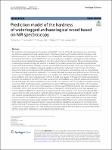Item Infomation
Full metadata record
| DC Field | Value | Language |
|---|---|---|
| dc.contributor.author | Liu, Tiantian | - |
| dc.contributor.author | Xi, Guanglan | - |
| dc.contributor.author | Han, Xiangna | - |
| dc.date.accessioned | 2023-10-09T03:39:37Z | - |
| dc.date.available | 2023-10-09T03:39:37Z | - |
| dc.date.issued | 2023 | - |
| dc.identifier.uri | https://link.springer.com/article/10.1186/s40494-023-01062-8 | - |
| dc.identifier.uri | https://dlib.phenikaa-uni.edu.vn/handle/PNK/9509 | - |
| dc.description | CC-BY | vi |
| dc.description.abstract | The significance of waterlogged archaeological wood (WAW) lies in its profound informational value, encompassing historical, cultural, artistic, and scientific aspects of human civilization, and therefore need to be properly studied and preserved. In this study, the utilization of near-infrared (NIR) spectroscopy is employed as a predictive tool for assessing the hardness value of WAW. Given the submerged burial conditions, waterlogged wooden heritage frequently undergo substantial degradation in their physical and mechanical properties. The mechanical properties of waterlogged wooden heritage are essential for evaluating their state of preservation and devising appropriate conservation and restoration strategies. However, conventional methods for testing mechanical properties are limited by factors such as the availability of adequate sample size and quantity, adherence to the “principle of minimum intervention,” and cost considerations. NIR spectroscopy is a non-destructive, rapid, sensitive, and low-cost analytical technique with great potential for application in this area. | vi |
| dc.language.iso | en | vi |
| dc.publisher | Springer | vi |
| dc.subject | WAW | vi |
| dc.subject | NIR | vi |
| dc.title | Prediction model of the hardness of waterlogged archaeological wood based on NIR spectroscopy | vi |
| dc.type | Book | vi |
| Appears in Collections | ||
| OER - Khoa học Vật liệu, Ứng dụng | ||
Files in This Item:

